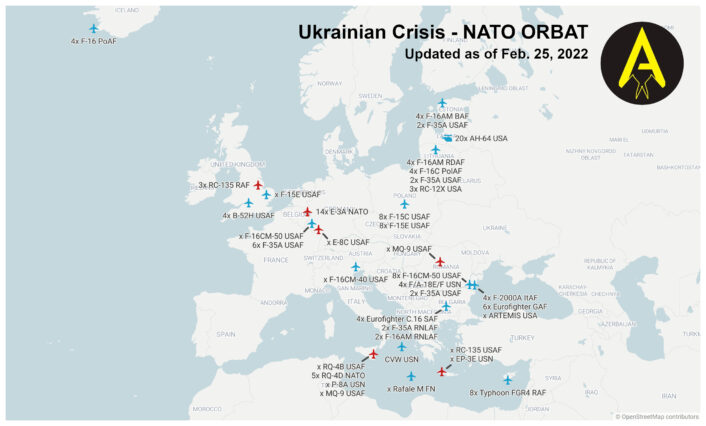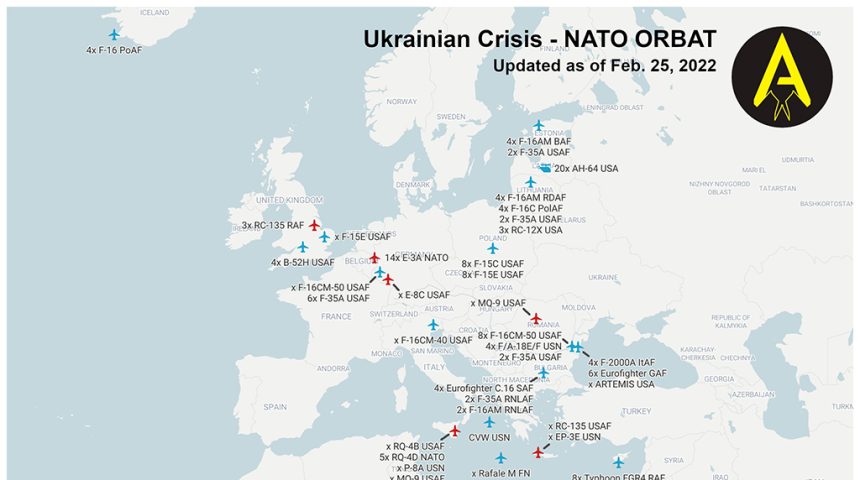NATO’s build-up continues following the invasion of Ukraine, with multiple fighter jets relocating and reinforcements arriving on the Eastern flank.
As we reported in the last 24 hours, following the Russian invasion in Ukraine, NATO assets started to relocate across the region to secure the alliance’s Eastern flank. The decision came as the international community begun condemning the Russian decision to attack Ukraine, as well as neighbouring countries invoking NATO’s Article 4, which states “The Parties will consult together whenever, in the opinion of any of them, the territorial integrity, political independence or security of any of the Parties is threatened.”
We noticed a quick shifting of the flight operations from Ukraine and Crimea to the neighboring countries, especially over Poland, Bulgaria and Romania, as well as a drastic increase in the ops tempo, with tanker and Intelligence, Surveillance and Reconnaissance tracks visible throughout the day. The tankers are supporting not only the ISR aircraft, but also multiple fighter formations conducting combat air patrols.
Some of the fighter jets could be observed yesterday as they flew to their assigned patrol area (like RAF Typhoons and USAFE F-16s departed from their home bases), but many others where not transmitting ADS-B and Mode S data. An estimate of the magnitude of the operations might come from the number of tankers on station at any time, with at least 6 flying at any time and replacements arriving on station as other tankers leave to return to base.
Well, that was certainly a public display.
RAF Eurofighter flying towards and then away 40 km from Kaliningrad Oblast. Seen via MLAT – open-source. (@ADSBexchange)
🇬🇧 RRR9778 is Typhoon FGR.4 ZJ947 #43C743 pic.twitter.com/kFOr3RYrWM
— Evergreen Intel (@vcdgf555) February 24, 2022
2255 Zulu RAF air policing activities this evening. ASCOT9847 (A332) departed RAF Akrotiri with x2 Typhoons for orbit over SE Romania, while on station, RRR9847 changed their callsign to KAYAK41 and then back to ASCOT, while ASCOT9098 (A332) was orbiting over Poland with Typhoons pic.twitter.com/pGvF5k7RDF
— Thenewarea51 (@thenewarea51) February 24, 2022
The aircraft involved are mainly US KC-135s and KC-10s, along with some British Voyagers and NATO MMF (Multinational Multi-Role Tanker and Transport Fleet) A330 MRTTs. As we often mention, the tankers are an incredible force multiplier which is essential for modern operations, not only in case of a large conflict but also in case of a smaller crisis response operation, allowing a virtually unlimited range and time on station to the air assets. The importance of their role is also highlighted by the tankers’ unofficial motto: Nobody Kicks A** Without Tanker Gas (NKAWTG).
We have little details about it, but as the fight continues in Ukraine, it looks like NATO is not only gathering valuable intelligence with plenty of ISR platforms (some of those visible on flight tracking platforms), it has probably established several CAP stations with fighters
— David Cenciotti (@cencio4) February 25, 2022
Dealing with fighter jets’ movements, let’s talk about the ones immediately redeployed as the events unfolded yesterday. A few days ago, we published a map showing all the aircraft involved in the daily operations in response to the crisis, including those already deployed and the ones arrived recently in Europe. Let’s see in detail which are all the aircraft involved (except resident nations forces) now that the situation has completely changed.
It’s night in Europe and four Boeing KC-135R tankers are still up over 🇵🇱Poland and 🇷🇴Romania. These may partly be for training purposes, but I do think we need to see them in the light of 🇺🇦Ukraine.
🇺🇸60-0335 #LAGR132
🇺🇸63-7999 #LAGR133
🇺🇸59-1475 #LAGR225
🇺🇸58-0125 #LAGR226 pic.twitter.com/aa2AWiSgMf
— Gerjon | חריון (@Gerjon_) February 24, 2022
The first ones to be moved were the U.S. Air Force F-35s that arrived last week at Spangdahlem Air Base, with half of them being sent to secure the Eastern flank in support of NATO’s collective defense. As we reported, the fifth gen aircraft will operate “for a period of time” from Estonia’s Amari Air Base, Lithuania’s Siauliai Air Base, and Romania’s Fetesti Air Base: two F-35s for each of these forward operating locations.
“We are facing a dynamic environment, and the deployment of F-35s to NATO’s eastern flank enhances our defensive posture and amplifies the Alliance’s interoperability,” said Gen. Jeff Harrigian, U.S. Air Force in Europe – Air Forces Africa commander in a public release.
The U.S. Air Force F-35s are not the only Lightning II rushed to the region. The Royal Netherlands Air Force has also deployed two F-35As to Bulgaria as part of a larger deployment of forces that include also RNLAF F-16s. The Dutch Ministry of Defence had previously announced the plan to deploy two of its 5th generation jets to Bulgaria between March and April, but the Russian invasion of Ukraine changed the initial plan.
It’s not clear whether the F-35s are being deployed to Graf Ignatievo or not: the official statement of the MOD says they have been moved “in the vicinity of Poland”. Anyway, what’s certain is that on their way to the destination, the F-35s flew over Poland and refueled from a RNLAF A330 MRTT north of Gniezno, Poland, where photographer Tomek Urbański spotted them.
Along with the F-35As caught on camera, the Dutch have also deployed to the Eastern Europe two F-16AM Fighting Falcons. The F-16s will complement the F-35s as part of a contingent of eight aircraft that can be deployed at any given time to protect NATO airspace over Eastern Europe. A video posted by the Dutch MOD shows the aircraft taxiing out of the HAS (Hardened Shelters) and take off with a load of Live AIM-120C/D AMRAAM and AIM-9X Sidewinder Air-to-Air Missiles, Sniper ATP (Advanced Targeting Pod) and the AN/ALQ-131 ECM pod.
The German Air Force augmented its detachment of Eurofighters at Mihail Kogalniceanu Air Base, Romania, where three jets of the Taktisches Luftwaffengeschwader 74 arrived last week, bringing the total to six aircraft. In accordance with the “plug & fight” concept, the German Eurofighters will continue to operate within the Italian-led eAPA-S (Enhanced Air Policing Area South) mission, contributing to the QRA (Quick Reaction Allert) service, carried out jointly with mixed aircraft, personnel and pilots belonging to both Air Forces.
According to news report, Denmark is expected to deploy, by the first half of March, two F-16s in Poland to perform air policing duties, in addition to the ones already deployed to Siauliai, Lithuania, last month to work alongside the Polish F-16s that deployed there in December 2021 to conduct Baltic Air Policing (BAP). Details about their deployment location are still unknown.
A quantity of attack helicopter is also being moved around. A battalion of attack aviation, made of 20 US AH-64D helicopters, was moved yesterday from Germany to a location in the Baltic region, later identified as Lielvarde airfield in Latvia. According to photos released on DVIDS, the helicopters belong to the 12th Combat Aviation Brigade stationed at Katterbach Army Airfield, Germany.
.@USArmy‘s 🇺🇸 AH-64 Apache helicopters belonging to the 12th Combat Aviation Brigade arrived at Lielvārde Air Base, Latvia 🇱🇻 in support of US-led multinational exercise #SaberStrike 22, Feb. 24, 2022. #StrongerTogether
📸 by SGT Ēriks Kukutis pic.twitter.com/xcWnRAl9xh
— Baltic Security (@balt_security) February 24, 2022
The arrival of the Apaches was first announced last week, in preparation for the bi-annual international exercise Saber Strike. The Lithuanian defence minister, however, described their arrival as part of the reinforcements after the Russian invasion of Ukraine. “These additional personnel are being repositioned to reassure our NATO allies, deter any potential aggression against NATO member states, and train with host-nation forces,” DOD officials said in a written statement.
Another attack aviation task force, made of 12 AH-64E helicopters and an unspecified number of UH60 Blackhawks, is being moved from Greece to Poland. The helicopters belong to the 1st Air Cavalry Brigade, which is in Europe for Atlantic Resolve at Stefanovikeio Air Base, Greece, according to the photos released on DVIDS. The location where they are being moved has not been disclosed.
In our first version of the map we did not include the Airborne Early Warning aircraft. According to flight tracking websites, NATO’s E-3 AWACS are operating over Eastern Europe from their home base at Geilenkirchen, Germany. It is not clear if any of the Sentrys are deployed to any of their forward locations over the European territory, although some reportedly launched from Konya, Turkey










